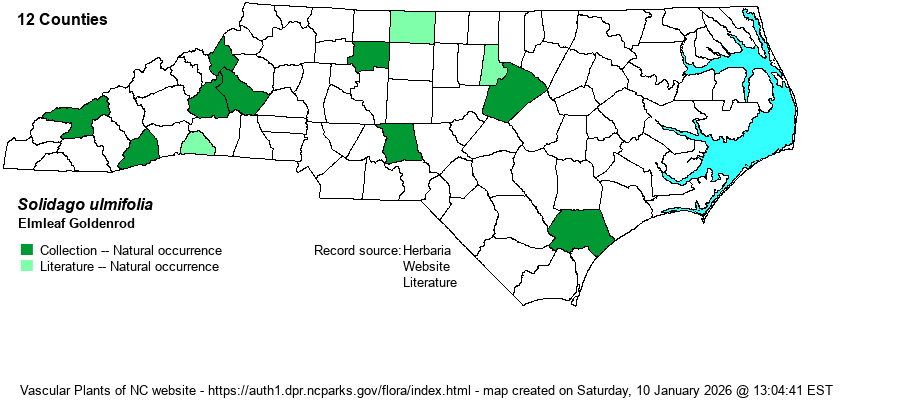| Author | Muhlenberg ex Willdenow | |
| Distribution | Though this is a distinct species, at least north of NC, there are many specimen records from across much of the state that have either been misidentified or might be misidentified (though difficult to be certain from review of specimens online), especially based on range or habitat. The identity of Elmleaf Goldenrod is unclear to the taxon editors. Specimens are not very consistent in their characters. Some specimens at SERNEC that were labeled as ulmifolia turn out to be S. rugosa var. rugosa, rugosa var. aspera, juncea, and latissimifolia (this last from Moore Co. at 16 herbaria!!). The range map below no doubt contains more records than in reality, as this is a northern species that is likely very rare in NC. Specimens checked at SERNEC in Jan. 2023 from Forsyth and Chatham counties are misidentified. Since none of the specimens at SERNEC have been annotated by Solidago experts, all NC records should be vetted. In a Feb 2023 email, Eric Ungberg and Vanessa Voelker of KYNHP agreed that a second specimen from Forsyth County (PH00255424 at Drexel Herbarium) is correctly identified. Eric and Vanessa doubted the ID of the other NC specimens at SERNEC, but cannot be positive until they are examined in hand.
NH to MN, and south to western FL and central TX. Scarce and poorly known in NC, SC, GA, and FL.
| |
| Abundance | Though common in the VA Mountains and northern Piedmont, it is scarce in that state in the central and southern Piedmont, including close to the NC border. It certainly has always been very rare or rare in NC (likely in the Mountains and northern Piedmont), but hardly any living NC biologists and botanists have seen it in NC, a disturbing situation. It has either declined greatly in recent decades, is passed over as S. rugosa (not likely) or another species, or has been misidentified in the past in collections to make it appear more wide-ranging in NC than in reality. Because of the confusing and uncertain occurrence of this species in the state, the NCNHP has changed the rank to simply SU (Undetermined); the website editors suggest S1?. It deservedly also is a Significantly Rare species. Of note, there are no NC photos of it on iNaturalist, even of "claimed" ones that are incorrect or uncertain correctness. | |
| Habitat | Mainly in moderate to high pH soils, in various forested or light-wooded settings. Can occur along stream banks, in rocky woods, in barrens/glades, and other places in mesic to somewhat dry settings. However, it is definitely a forest-based species, not found in open fields or even normally along woodland borders. | |
| Phenology | Flowers and fruits from August-October. | |
| Identification | This is a rather elegant species, growing 2-4 feet tall, with a glabrous stem, though the flower branches are pubescent. The numerous leaves (all on the stem) are elliptical, thin and not scabrous above, serrated on the margins; they may have a short stalk or be nearly sessile. The inflorescence is widely spreading, with many arcing branches (elm-like) of flower heads on a single side of the branch. However, members of the S. rugosa complex also have this same general growth form and spreading inflorescence, so care must be taken to separate these two species. Elmleaf Goldenrod has a smooth stem, whereas that species (complex) has a rough/hairy stem and the leaves are either rough/scabrous above and/or are quite wrinkled (as opposed to mostly smooth, thin, and not wrinkled). Botanists are urged to look for this species in hopes of learning its true identification characters and its true status in NC. | |
| Taxonomic Comments | Weakley (2018) lists the nominate variety as occurring in the state; however, in 2024, his flora eliminates varieties for the species.
| |
| Other Common Name(s) | None | |
| State Rank | SU [S1?] | |
| Global Rank | G5 | |
| State Status | SR-O | |
| US Status | | |
| USACE-agcp | | |
| USACE-emp | | |

